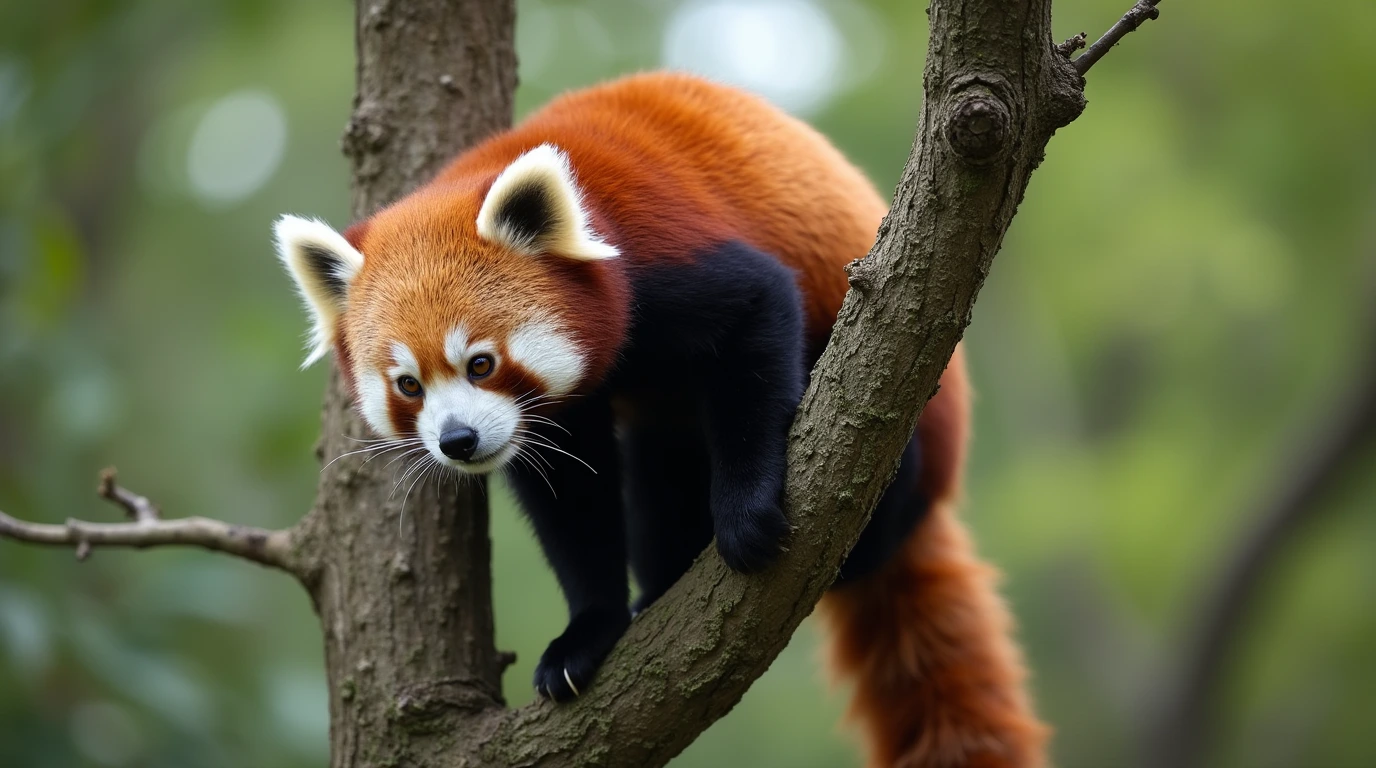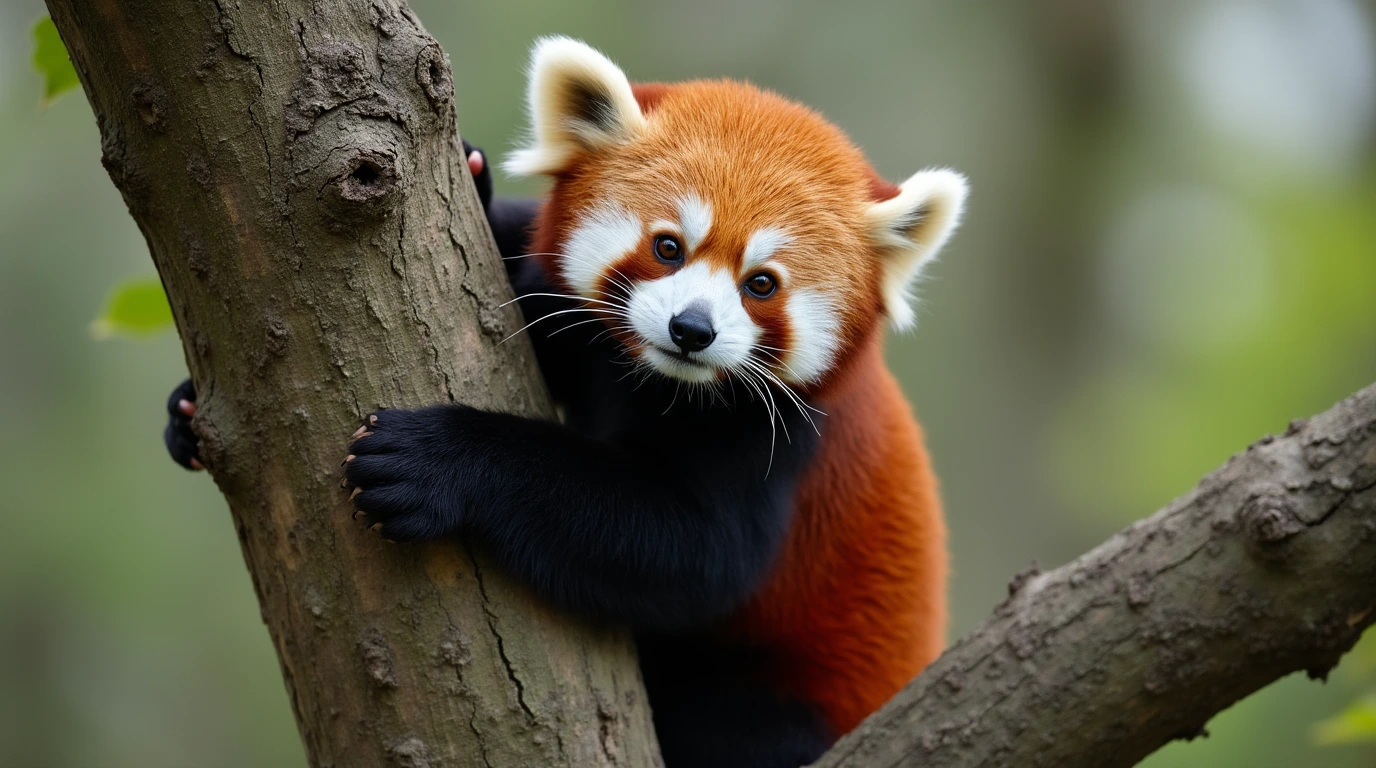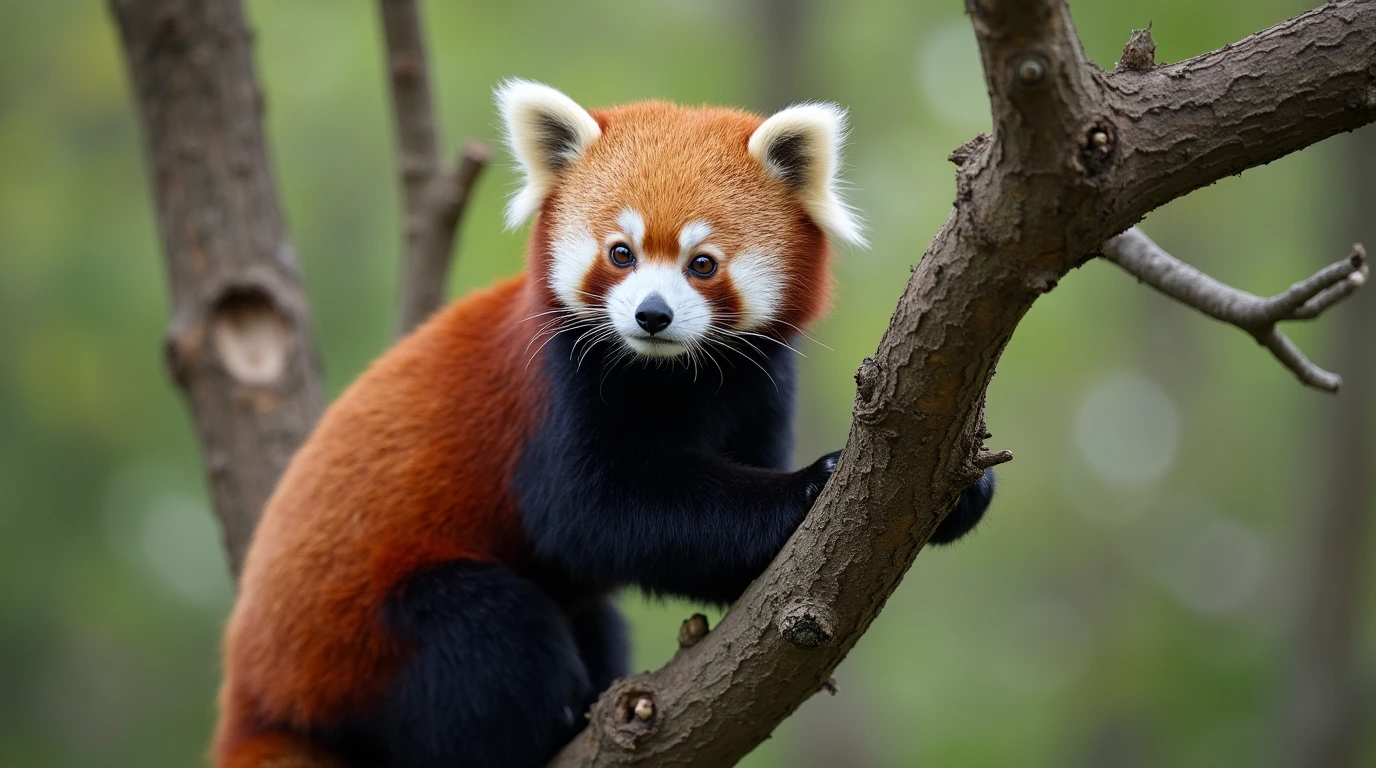Red pandas are among the most agile tree-dwelling mammals, thanks to a range of specialized adaptations that make them expert climbers. Their flexible ankles allow them to rotate their feet outward, enabling them to descend trees headfirst—a rare skill among mammals. Their semi-retractable claws provide a strong grip, while their pseudo-thumb, an extended wrist bone, helps them grasp branches securely
Additionally, their bushy tail aids in balance, and their fur-covered soles enhance traction on slippery bark. These adaptations are not just for convenience; they are essential for survival, helping red pandas evade predators, efficiently forage for food, and find secure resting spots. In this article, we’ll explore the physical traits that make red pandas such exceptional climbers, how they use their tails and feet to navigate trees, and the evolutionary advantages of their arboreal skills
Unique Physical Adaptations That Make Red Pandas Excellent Climbers

Red pandas possess a remarkable set of physical traits that make them one of the most skilled climbers in the animal kingdom. Their bodies are specially adapted for an arboreal lifestyle, allowing them to navigate the dense forests of the Himalayas and southwestern China with ease. From flexible ankles that let them descend trees headfirst to sharp claws that provide a powerful grip, every aspect of their anatomy is fine-tuned for climbing
One of their most unique features, the pseudo-thumb, enhances their dexterity, making it easier to grasp branches and bamboo. These adaptations not only aid in movement but also play a key role in their survival, allowing them to escape predators and efficiently forage for food
The Role of Flexible Ankles in Tree Navigation
One of the most distinctive climbing adaptations in red pandas is their highly flexible ankles. Unlike most tree-dwelling mammals, which must climb down trees backward to maintain control, red pandas can descend headfirst. This ability is made possible by their ankle joints, which can rotate outward nearly 180 degrees. This extreme flexibility allows them to grip the bark securely, maintaining balance and stability as they move
According to the Smithsonian’s National Zoo, this adaptation is particularly useful for navigating the steep, dense forests where red pandas live. By descending headfirst, they can quickly escape predators such as snow leopards and martens, which often rely on vertical escape routes. This unique movement pattern also helps red pandas access food sources located on lower branches without having to reposition themselves awkwardly
Additionally, their rear foot structure provides extra support. Unlike many other climbing mammals, red pandas lack a fully opposable thumb, making their ankle flexibility even more critical for grasping and maneuvering along tree trunks. This adaptation not only enhances their climbing efficiency but also reduces energy expenditure, allowing them to conserve energy in their low-calorie bamboo diet
How Sharp, Semi-Retractable Claws Improve Grip
Red pandas have sharp, semi-retractable claws that play a crucial role in their climbing ability. These claws work much like a cat’s, providing enhanced traction when climbing trees and walking on uneven surfaces. When gripping tree bark, their claws dig in deeply, allowing them to maintain a secure hold even on vertical surfaces
One advantage of semi-retractable claws is that they remain sharp over time. Unlike fully extended claws that wear down more quickly, red pandas’ claws can partially retract, keeping them sharp for better climbing efficiency. This adaptation is essential for navigating slippery or unstable branches, especially in wet or snowy conditions common in their natural habitat
Beyond climbing, their claws are also useful for handling food. Since red pandas primarily eat bamboo, fruits, and small invertebrates, they use their claws to strip leaves from branches, dig into bark, and grasp food items with precision. This added dexterity allows them to feed efficiently without relying solely on their pseudo-thumb
The Importance of the Pseudo-Thumb for Climbing and Feeding
Perhaps one of the most fascinating adaptations of red pandas is their pseudo-thumb—a modified extension of the sesamoid bone in their wrist. This structure functions as an extra digit, providing red pandas with improved grip strength when climbing and handling food
While giant pandas also have a pseudo-thumb for grasping bamboo, red pandas use theirs for both climbing and feeding. The Current Conservation journal highlights how this adaptation allows red pandas to securely grip tree branches, enhancing their stability and control as they move through the canopy
The pseudo-thumb is especially beneficial when combined with their semi-retractable claws. Together, these features allow red pandas to grasp thin branches with precision, making it easier for them to navigate the treetops while searching for food. When feeding, the pseudo-thumb provides additional dexterity, allowing red pandas to manipulate bamboo stalks and other food sources with ease
This adaptation is a prime example of convergent evolution, where different species develop similar traits to solve the same survival challenges. Though red pandas are not closely related to giant pandas, both have evolved this unique wrist modification to aid in grasping—highlighting its importance in arboreal environments. To learn more about how red pandas use their unique anatomy to navigate trees, check out this detailed explanation from the National Zoo, which explores their flexible joints, strong claws, and pseudo-thumb function
How Red Pandas Use Their Tails and Feet to Master the Trees

Red pandas are not only agile climbers because of their flexible ankles and sharp claws, but they also rely on their long, bushy tails and specialized foot adaptations to move effortlessly through the treetops. Their tails help them balance, acting as counterweights when walking on thin branches, while their fur-covered soles provide better grip on slippery surfaces
Additionally, their flexible limb joints allow them to adjust their body position quickly, ensuring they can navigate their arboreal environment with precision. These physical traits work together to give red pandas an impressive ability to climb, maneuver, and rest securely in trees
The Balancing Function of a Red Panda’s Bushy Tail
One of the most visually striking features of a red panda is its long, fluffy tail, which measures between 11 to 19 inches—about the same length as its body. While the tail’s striped pattern provides camouflage in the dense forests, its primary function is to assist with balance and stability
Red pandas frequently move across thin, unstable branches, where even a small shift in weight can cause a fall. Their bushy tails act as counterbalances, allowing them to distribute their weight evenly and maintain equilibrium as they walk. This adaptation is especially helpful when climbing at steep angles or leaping between trees, where precision is critical
Beyond balance, the tail also serves another important function: insulation against the cold. Red pandas inhabit mountainous regions, where temperatures can drop significantly, especially at night. By curling their tail around their body while sleeping, they conserve heat and protect themselves from the elements. This feature is particularly useful in winter, when snow and ice make their environment even more challenging
According to the Redwood Zoo, this multi-functional tail is one of the reasons red pandas can thrive in such extreme habitats. Their ability to use it both for balancing in trees and retaining warmth gives them an evolutionary advantage in their high-altitude forest environment
Why Fur-Covered Soles Provide a Climbing Advantage
Unlike many mammals that rely solely on rough pads for traction, red pandas have thick fur covering the soles of their feet. This adaptation is vital for survival in their cold, wet, and often snowy habitat, as it provides both insulation and improved grip
The fur-covered soles serve two primary functions:
Thermal Insulation: Since red pandas live at elevations between 7,200 and 15,700 feet, where temperatures can drop well below freezing, their foot fur acts as a natural insulator, preventing heat loss when walking on snow-covered branches
Enhanced Traction: The fur on their feet increases friction, allowing them to grip tree bark more securely. This feature is particularly beneficial when climbing wet or icy surfaces, reducing the risk of slipping
Additionally, their paw pads are equipped with strong, curved claws, which work in conjunction with their fur-covered soles to maximize grip. This makes red pandas particularly well-adapted to their environment, where stable footing is essential for both climbing and escaping predators
Flexible Limb Joints and Their Impact on Mobility
Red pandas have evolved highly flexible limb joints, which allow them to move with ease in the treetops. Unlike many terrestrial mammals, whose joints are designed primarily for forward motion, red pandas’ joints enable them to rotate their legs in multiple directions, providing greater control when climbing
This flexibility is particularly useful for:
Changing direction quickly: Red pandas often navigate complex, multi-branch pathways, requiring sudden shifts in movement. Their adaptable limb structure allows them to do this efficiently
Climbing at different angles: Whether ascending, descending, or moving horizontally, their joints allow them to adjust their positioning effortlessly
Hanging and gripping with their hind legs: Red pandas can anchor themselves with their hind limbs, freeing up their front paws for foraging or grasping branches
The Current Conservation journal highlights how this mobility gives red pandas a survival advantage in an environment where they need to be agile and responsive to potential threats. Their flexible joints enable them to escape from predators more effectively and quickly shift between feeding spots, making them highly efficient climbers
For a deeper dive into how red pandas use their tails and feet to navigate trees, check out this in-depth resource from the Redwood Zoo, which explains their balancing adaptations and climbing efficiency
Evolutionary Benefits of Red Pandas’ Climbing Abilities

Red pandas’ exceptional climbing skills are not just physical adaptations; they are essential survival tools shaped by millions of years of evolution. Their ability to move effortlessly through the trees provides them with distinct advantages in escaping predators, finding food, and securing safe nesting sites
In their natural habitat—high-altitude forests in the Himalayas and China—being able to climb with precision means the difference between life and death. These arboreal adaptations help red pandas evade threats, access nutrient-rich food sources, and create safe dens for raising their young
How Climbing Helps Red Pandas Escape Predators
One of the primary reasons red pandas are such skilled climbers is predator avoidance. Unlike large predators that rely on speed or strength for survival, red pandas depend on their agility and ability to escape into the treetops
Their main threats include:
Snow leopards, which are powerful climbers but less agile than red pandas when navigating thin branches
Martens, small carnivores that prey on young red pandas but struggle to pursue them in the canopy
Leopards and wild dogs, which primarily hunt on the ground and cannot reach them once they ascend into trees
By using their flexible ankles, sharp claws, and strong grip, red pandas can climb to safety in seconds. Their headfirst descent ability, unique among tree-dwelling mammals, allows them to quickly move downward if a predator is approaching from above. This skill is a significant advantage in the dense, foggy forests where visibility is often low
Research from the Smithsonian’s National Zoo highlights how red pandas use trees as their primary escape strategy, relying on their climbing skills rather than speed or aggression. Since they are solitary animals with few social defense mechanisms, their ability to flee vertically is crucial for survival
The Connection Between Arboreal Skills and Foraging Efficiency
Red pandas’ diet is heavily dependent on bamboo, which grows in dense forests with uneven terrain. Unlike giant pandas, which feed on bamboo from the ground, red pandas often climb into bamboo thickets or trees to reach fresh leaves and shoots. Their pseudo-thumb and strong claws allow them to grasp bamboo stalks with precision, stripping the leaves efficiently
Beyond bamboo, climbing provides red pandas access to:
Tree fruits, berries, and acorns, which are seasonally available in the canopy
Bird eggs and small insects, which supplement their diet with protein
Water sources, such as rainwater collected in tree hollows, which they can drink from without descending to the forest floor
Studies suggest that red pandas’ arboreal foraging strategy reduces competition with other bamboo-eating species. While ground-dwelling herbivores may deplete lower bamboo layers, red pandas can reach higher, less accessible food sources, ensuring a more stable food supply throughout the year
Nesting and Resting: Why Trees Are Essential for Survival
Red pandas are primarily nocturnal and crepuscular, meaning they are most active during dawn and dusk. During daylight hours, they prefer to rest in tree branches or hollow logs, where they are safer from predators
Their climbing adaptations allow them to:
Find secure nesting sites in tree cavities, which provide shelter from harsh weather and predators
Sleep curled up on high branches, using their tails as insulation against the cold
Give birth in tree hollows, where their young remain hidden and protected during the vulnerable first weeks of life
According to the Current Conservation journal, red pandas’ nesting behavior is critical for their survival in the wild. Unlike species that build nests on the ground, they rely on their climbing ability to locate elevated shelters that reduce predation risks. For further insights into how evolution has shaped red pandas’ climbing adaptations, explore this detailed analysis from Current Conservation, which explains their arboreal lifestyle and survival strategies













